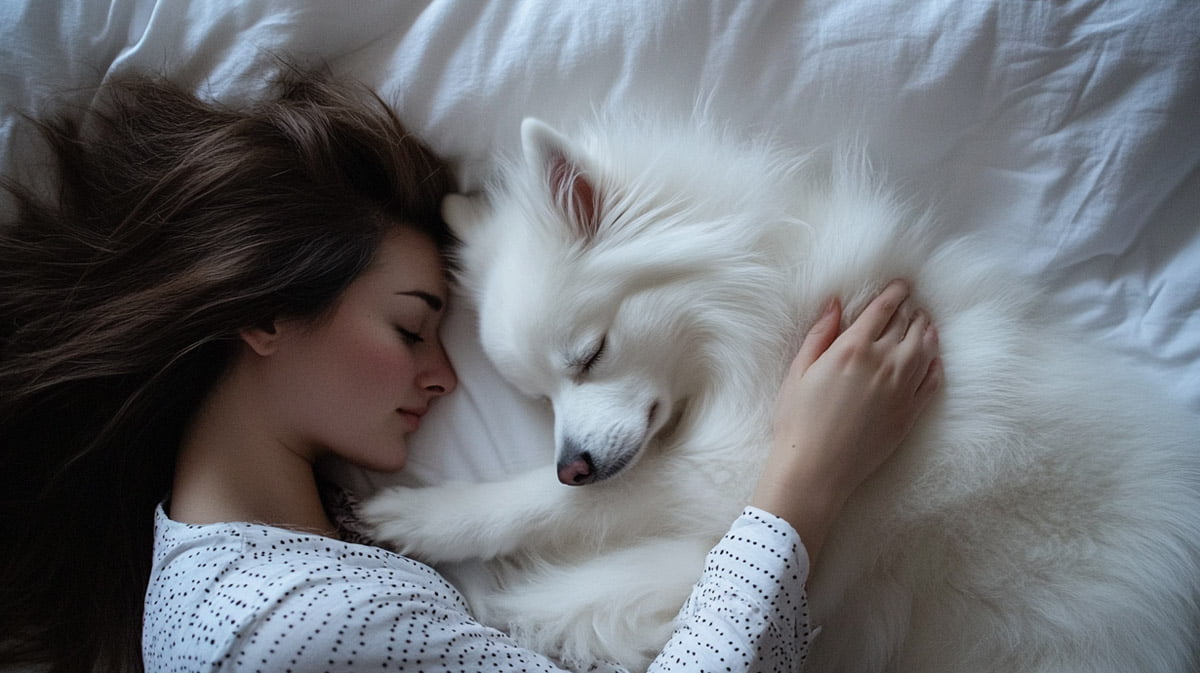Letting your dog sleep on the bed is a hotly debated topic among pet owners. For some, it’s a no-brainer—they want their furry friend curled up next to them every night. For others, it’s a strict “no dogs allowed” policy. But what’s the real scoop? Is it a good idea, or are there downsides?
As a proud owner of Atari, my mischievous Japanese Spitz, I’ve lived both sides of the bed-sharing debate. In this article, we’ll look at the pros and cons, share some scientific insights, and talk about how Atari went from a crate sleeper to the ultimate bed-hogger!
Should You Let Your Dog Sleep With You?
There’s no simple answer to this question. It depends on you, your dog, and your lifestyle. However, research suggests that letting your dog sleep with you can strengthen your bond and enhance feelings of safety.
According to the American Kennel Club (AKC), 45% of dog owners let their pups sleep in bed with them, and many report it helps with feelings of companionship and emotional support.
But before you make a decision, there are a few things to consider.

Benefits of Letting Your Dog Sleep on the Bed
Strengthening the Bond Between You and Your Dog
Co-sleeping with your dog can enhance your bond. Dogs are social animals, and sleeping in close proximity to their humans can increase trust and attachment.
Studies have shown that dogs who sleep with their owners are more responsive to commands and tend to display stronger emotional bonds.
For me, the connection with Atari grew stronger once we allowed her onto the bed. It became our little nighttime routine—she’d curl up near my feet, wagging her tail softly as if to say, “I’m home.”
Enhanced Mental Health and Comfort
One of the biggest perks is emotional comfort. Petting or cuddling a dog increases oxytocin levels, often called the “love hormone.” According to the Anxiety & Depression Association of America, the “pet effect” has a profound impact on mental health, reducing anxiety and promoting calmness. Co-sleeping takes this effect to the next level.
Personally, having Atari next to me has made stressful days melt away. Something is soothing about hearing her gentle snore or feeling her fluffy fur when the world feels too much.
A Built-in Heater on Cold Nights
Dogs are natural heaters. They run a few degrees hotter than humans, with a body temperature between 37.5°C and 39°C. In winter, Atari transforms into my personal heater, cuddling up and keeping the chill at bay. It’s incredibly comforting when I could use that extra warmth during Melbourne’s colder months.

What to Consider Before Letting Your Dog Sleep on the Bed
Sleep Disruptions: The Dog’s Nocturnal Habits
One of the main drawbacks to having your dog in bed is sleep disruption. While some studies suggest that co-sleeping doesn’t necessarily decrease sleep quality, each dog’s habits differ.
Dogs, including Atari, are natural light sleepers and tend to shift positions multiple times throughout the night. This can wake you up, especially if your dog is restless.
Allergies and Hygiene
If you’re prone to allergies, having your dog in bed might not be the best idea. According to the Asthma and Allergy Foundation of America, around 10% to 20% of people are allergic to pets (both dogs and cats). This can exacerbate symptoms, mainly when dog hair and dander are concentrated on your bedding.
Atari’s plush white coat leaves behind little fur tumbleweeds that require frequent cleaning. We’ve managed this by regularly brushing, frequently vacuuming, and ensuring our sheets are washed more often than usual.
The Bed Hog Factor
Dogs, no matter their size, have a way of expanding to take up the whole bed. Despite being on the smaller side, Atari has somehow mastered the art of claiming more than her fair share of the mattress. She starts off at the foot of the bed at night but gradually wiggles her way up until I’m balancing on the edge. It’s a common, funny frustration many dog owners face.
How to Co-Sleep With Your Dog Successfully
If you decide to let your dog share your bed, here are a few tips to make the experience comfortable for both of you.
Set Boundaries Early
Teaching your dog where they can and cannot sleep is crucial. For Atari, we’ve set a rule that she stays at the foot of the bed. It took a little training, but she now knows that’s her designated sleeping spot, which leaves the rest of the bed for us.
Keep the Bed Clean
Keeping things hygienic is important, even if you’re okay with dog hair on your sheets. Regular grooming can help control shedding, and washing your bedding more frequently can prevent any allergens or dirt from building up. We also have a special blanket just for Atari, making cleanup easier.
Have a Backup Bed
Sometimes, even your dog may want its own space. Providing a comfy, dedicated dog bed nearby allows your pup the option to sleep off the bed if it gets too warm or cramped. Atari has her own plush dog bed next to ours, which she retreats to when she wants extra room to stretch out.
The Health and Hygiene Considerations
Sharing your bed with your dog isn’t inherently dangerous, but there are a few health concerns to keep in mind.
- Allergens: Even if you don’t have allergies now, prolonged exposure to dog dander can sometimes trigger them. Brushing Atari daily has helped us manage this, especially during shedding season.
- Illnesses and Pests: Preventative care is essential. Keeping your dog flea- and tick-free ensures no unwelcome guests in your bed. Check regularly for pests and keep up with vet-recommended treatments.
- Dog Health Concerns: Some dogs, especially seniors, may struggle with jumping on and off the bed, potentially injuring themselves. Consider using pet stairs or a ramp if your dog is older or has joint issues. Atari, though still sprightly, may need this help as she gets older.
FAQs: Should You Let Your Dog Sleep on the Bed?
Are Dogs Happier Sleeping in Bed with Their Owners?
Many dogs do enjoy the comfort of sleeping close to their owners. However, it’s important to note that dogs adapt well to routine. As long as they have a warm, cozy space, they’re typically content, whether on the bed or in their own area.
Does Co-Sleeping Cause Separation Anxiety?
There’s no clear evidence that letting your dog sleep in your bed causes or worsens separation anxiety. In fact, for some dogs, sleeping in close proximity helps reduce stress and anxiety. However, if your dog already suffers from severe separation anxiety, veterinarians might recommend having them sleep independently to foster confidence.
What Age Can a Dog Start Sleeping in Bed with You?
It’s best to wait until your dog is fully house-trained and has learned basic commands before allowing them to sleep in your bed. Many veterinarians recommend waiting until they’re at least a year old. Atari didn’t get bed privileges until she mastered house training—she earned her spot!
Conclusion: To Sleep or Not to Sleep with Your Dog?
Ultimately, whether you allow your dog to sleep in your bed depends on your preferences and your dog’s behaviour. If you enjoy the warmth, companionship, and bonding that comes with co-sleeping, go ahead and make the bed dog-friendly. Just be sure to consider potential disruptions, hygiene, and your dog’s health as they age.
As for me and Atari, we’ve settled into a nighttime routine that works for both of us—though she still manages to claim more than her fair share of the bed! And honestly, despite the occasional snoring or fur-covered pillow, I wouldn’t have it any other way.







